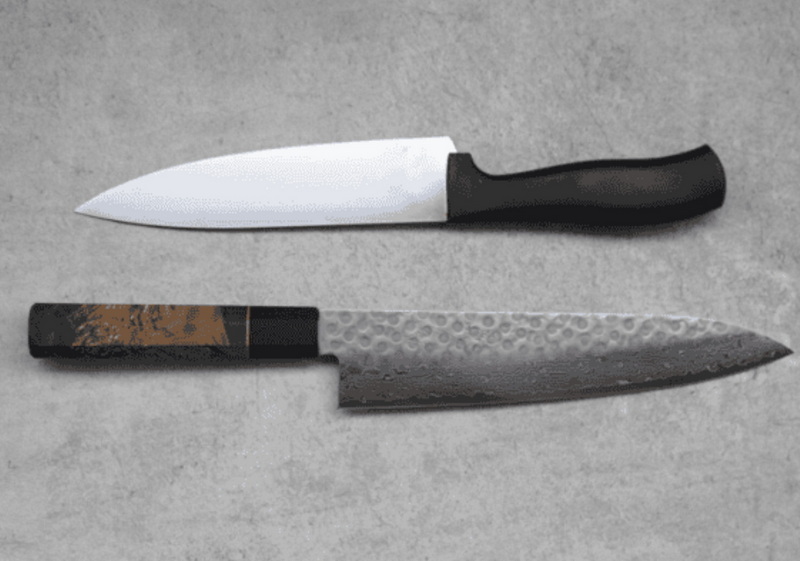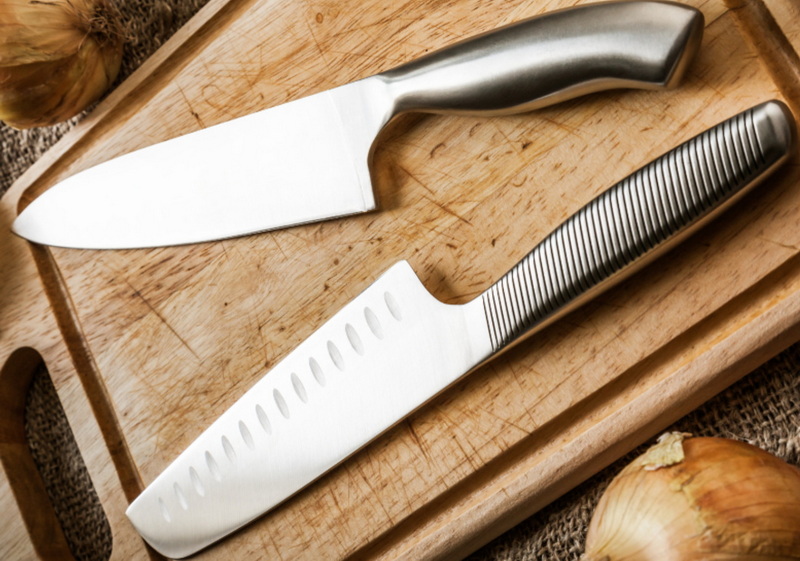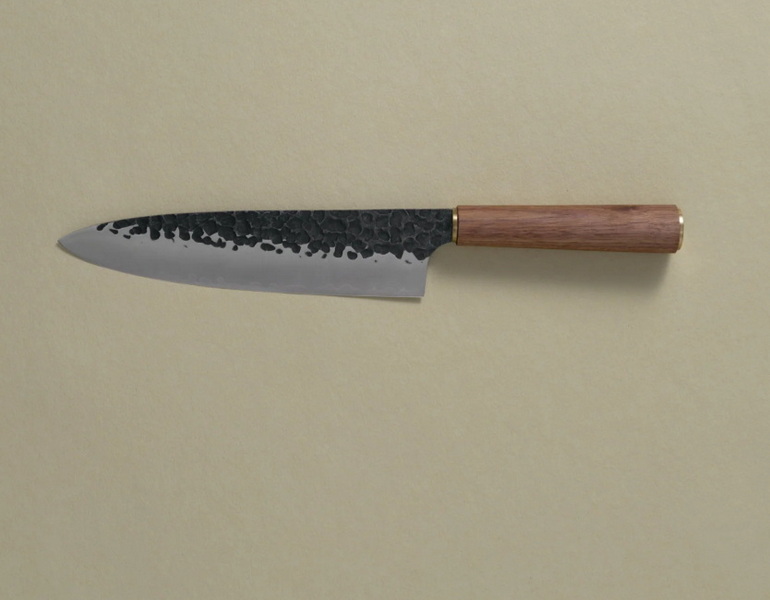- All
- Product Name
- Product Keyword
- Product Model
- Product Summary
- Product Description
- Multi Field Search
Views: 222 Author: Ann Publish Time: 2025-10-30 Origin: Site











Content Menu
>> Cross-Section and Blade Shape
>> Materials and Heat Treatment
>> Edge Retention and Maintenance
>> Grip Materials and Ergonomics
>> Food Texture and Task Suitability
● Care, Maintenance, and Longevity
● Materials Considerations for OEM Partners
>> Plating, Corrosion Resistance, and Finish
>> Brand Positioning, Packaging, and Education
>> Market Trends and OEM Implications
>> Case Studies and Practical Applications (Illustrative)
>> Care and Training Resources for End Users and Partners
>> Sustainability Considerations for OEM Programs
● FAQ
>> What is the main difference between Western and Japanese steak knives in terms of edge geometry?
>> Are Japanese steak knives more prone to chipping than Western knives?
>> Which type is better for bone-in cuts?
>> What maintenance practices improve longevity for these knives?
>> How should an OEM brand present care guidance to customers?
Steak Knife selections often mirror broader culinary tool philosophies: Western and Japanese designs embody distinct approaches to edge geometry, handle ergonomics, materials, maintenance, and intended dining contexts. This article unpacks these differences in a structured, buyer-focused way, highlighting how each style aligns with different cuisines, service environments, and OEM branding opportunities. Readers will gain practical insights for sourcing, customization, and education content that supports international brand partners, distributors, and manufacturers seeking to optimize “Steak Knife” offerings across regions.

- Western steak knives typically employ a double-bevel edge with a broad, durable cutting surface. Common edge angles range from 18° to 22° per side, which provides a robust balance between sharpness and resilience in everyday restaurant use. This geometry favors versatility, allowing efficient performance across meats, vegetables, and occasional bone contact in some contexts. For OEM buyers, Western geometry supports standardized production and broad compatibility with cutlery presentation styles.
- Japanese steak knives frequently use a finer edge with lower bevel angles, often 10° to 15° per side, and may include single-bevel configurations for highly specialized tasks. The result is an exceptionally sharp, precise cut with reduced resistance in soft proteins and delicate slices. However, the edge can be more susceptible to chipping or requiring more meticulous maintenance when used with harder bones or heavy-duty tasks.
- Western blades tend to be thicker and have a fuller, more curved profile that supports rocking motions and vigorous cutting. The geometry emphasizes durability and forgiving performance under high-volume workloads in Western-style dining rooms and steakhouses.
- Japanese blades often present a thinner cross-section and a flatter or more linear edge profile, enabling wafer-thin slices and refined presentation. This geometry excels in precision tasks like portioning marbled steaks, slicing sashimi-style textures, or achieving uniform thickness in plated steaks.
- Western steak knives often utilize stainless steels with balanced hardness and corrosion resistance. The focus is on high durability, ease of maintenance, and compatibility with broad sanitization protocols in busy kitchens.
- Japanese steak knives frequently use high-carbon stainless or alloyed steels that can achieve harder microstructures, enabling an ultra-sharp edge and extended edge retention when properly maintained. The trade-off is greater vulnerability to corrosion if care routines are lax, making proper drying and storage crucial in professional settings.
- Western knives are generally more forgiving in maintenance cycles; routine stropping and occasional professional sharpening can restore performance without excessive downtime.
- Japanese knives may demand more disciplined maintenance, including regular honing and careful periodic sharpening with appropriate stones to retain the intended micro-bevel geometry. For OEM clients, providing customer education and care guides is essential to maintain performance over time.
- Western steak knives commonly feature riveted, full-tang handles or industrially robust scales, often constructed from wood, polymer, or composite materials. The emphasis is on durability, interchangeability, and ease of mass production in factory settings.
- Japanese steak knives regularly adopt wa-style handles or simpler, lighter stick tang designs. The balance point is frequently located closer to the blade, offering heightened control for precise slicing and delicate cuts. In some models, handles may be replaceable or integrated, reflecting a traditional Japanese approach to tool longevity and repairability.
- Western models tend to be heavier, distributing weight along the blade to produce a confident chopping feel and a forgiving stroke for rugged meats and bone-in segments.
- Japanese models are often lighter, engineered to reduce wrist fatigue for long service periods in fine-dining contexts and for chefs who favor a refined, slicing motion over power.
- Western grips prioritize slip resistance and durability under frequent washing; common materials include polymer composites and stabilized woods with textured surfaces.
- Japanese grips emphasize a smooth, ergonomic interaction with the hand, often featuring rounded profiles and moisture-friendly textures suited for precise, controlled cuts.

- Western steak knives excel in handling thicker cuts, marbling-rich portions, and tougher textures demanding sturdy, stable performance. They are well-suited for banquet settings, steakhouses, and general-purpose kitchen lines where versatility is valued.
- Japanese steak knives shine in precision work: thinly sliced beef sections, delicate seafood integrations, and plated presentations requiring razor-like accuracy. They are favored in high-end restaurants where visual perfection and clean edges are critical.
- In high-volume Western kitchens, the heavier build and robust edge support reduce fatigue during repetitive tasks and make multi-piece service easier to manage under time pressures.
- In precision-focused operations, such as sushi bars or tasting-menu restaurants, the lighter weight and finely tuned balance of Japanese knives enable chefs to execute delicate cuts with consistent thickness and minimal tearing.
- After use, knives should be washed by hand with mild detergent, rinsed, and thoroughly dried to prevent mineral deposits or corrosion. This is particularly important for high-carbon steels common in Japanese designs.
Storage and Protection
- Store knives in a manner that protects the edge and reduces nicks—slot reducers, magnetic blocks, or protective blade guards are recommended. For OEM programs, consider packaging that includes edge-protection inserts and care instructions.
Sharpening and Honing
- Western knives typically respond to standard sharpening systems and varying stone grits; routine honing helps keep the edge aligned between professional sharpening sessions.
- Japanese knives usually benefit from a dedicated sharpening routine with appropriate stones (coarse to fine grits) and careful maintenance of any micro-bevel or single-bevel configurations. Providing customers with a recommended sharpening schedule improves long-term performance.
- Stainless variants with improved corrosion resistance are common in Western lines, aiding performance in diverse kitchen environments and simplifying maintenance for end-users.
- For premium Japanese lines, high-carbon stainless or traditional carbon steels require explicit care messaging and possibly coatings or protective finishes to reduce staining risk in regions with humid climates or aggressive seasoning regimens.
- Western-style steak knives align well with mass-market branding, value-driven packaging, and broad culinary narratives that emphasize durability and versatility. Educational content should focus on edge longevity, everyday use, and compatibility with varied service settings.
- Japanese-style steak knives support premium branding, meticulous craftsmanship narratives, and elite dining experiences. Packaging can highlight blade geometry, hand-finished finishes, and recommended care routines to preserve visual appeal and performance.
- The global demand for both Western and Japanese knife aesthetics continues to grow, with OEM manufacturers increasingly offering hybrid lines that blend durability with precision, or provide interchangeable handle systems to satisfy diverse client preferences. In addition, digital marketing and product education (videos, diagrams, and 3D models) enhance perceived value and assist distributors in presenting clear, region-specific contrasts during sales pitches.
- For OEM clients targeting multi-regional distribution, providing a family of products that includes a Western-style workhorse and a Japanese-style precision option allows brands to cover both labor-intensive and haute cuisine segments, thereby broadening the addressable market while maintaining consistent manufacturing frameworks.
- Case A: A mid-range restaurant chain seeks a dual-portfolio strategy. They select a Western steak knife family for general-purpose service and a refined Japanese steak knife line for premium tasting menus and seafood-focused meals. The OEM program includes interchangeable handle modules and standardized blade finishes to optimize production efficiency across both lines.
- Case B: A luxury hotel group wants a cohesive set with unique branding elements. The OEM package includes laser-engraved logos, custom handle materials, and a range of packaging options that reinforce the brand's premium image while maintaining uniform maintenance instructions for guests.
- End-user guidance: concise care cards, video tutorials, and model-specific sharpening guides help customers maintain performance and extend tool life.
- Distributor resources: detailed spec sheets, comparative charts, and regional storage and care recommendations enable accurate demonstration and faster decision-making.
- Material selection and production processes should consider environmental impact, including steel sourcing, finishing processes, and packaging optimization. Providing eco-friendly packaging options and documenting responsible sourcing strategies can enhance appeal to sustainability-conscious markets.
Western and Japanese steak knives embody distinct culinary tool philosophies, each delivering specific advantages aligned with different dining contexts, cuisines, and branding narratives. Western designs prioritize durability, versatility, and ease of maintenance, making them well-suited for high-volume, multi-task service environments and broad OEM distribution. Japanese designs emphasize precision, edge refinement, and tactile control, catering to premium dining experiences, meticulous plating, and brand differentiation through craftsmanship. For OEM partners, the most effective strategy often involves a balanced portfolio: a robust Western-style steak knife line for everyday performance and a refined Japanese-style line for specialty applications, complemented by clear care guidance and visually compelling packaging. By aligning design choices with target markets, culinary cultures, and end-user expectations, kitchen knife brands can maximize the appeal of “Steak Knife” offerings across regions while maintaining scalable production and compelling OEM value propositions.

Western steak knives typically feature a double-beveled edge with angles around 18°–22° per side, prioritizing durability and versatility; Japanese steak knives often use lower angles around 10°–15° per side (and may include single-bevel variants) to achieve superior initial sharpness and precision.
Yes, due to higher hardness and finer edge geometry, Japanese knives can be more susceptible to chipping if used on hard or bone-in tasks; proper technique and appropriate usage contexts are essential.
Western-style steak knives are generally better suited for bone-in work because of their thicker blades, sturdier construction, and forgiving edge geometry, though some high-end Japanese lines with reinforced blades can perform well in controlled settings.
Regular hand washing and thorough drying, appropriate storage, and routine sharpening/honing tailored to blade type are key. Western knives are typically easier to maintain, while Japanese knives require careful sharpening with suitable stones and attention to micro-bevel geometry.
Provide clear, region-specific care instructions, including recommended cleaning methods, drying procedures, storage solutions, and a documented sharpening schedule; consider including video tutorials and illustrated care cards as part of the packaging.
The Ultimate Professional Knives for Halal Butchery in Middle Eastern Kitchens
Chef Knife Size Guide: Choosing Between 6″, 8″, 10″, And 12″
Custom Knife Handles: How To Design A Chef Knife That Fits Your Hand Perfectly
Chef Knife Surface Treatments Guide: From Polished Migaki To Damascus Patterns
Inside Our Professional Knife Sample Room: Quality You Can See
Universal Knife Block Buying Guide: Modern Acrylic & ABS Knife Holders for Professional Kitchens
Universal Knife Block: The Complete Guide To Modern, Hygienic Knife Storage
The Complete Guide To Red Handle Knife Sets: Style Meets Functionality in The Kitchen
Professional Knives for Halal Butchery And Middle Eastern Cuisine